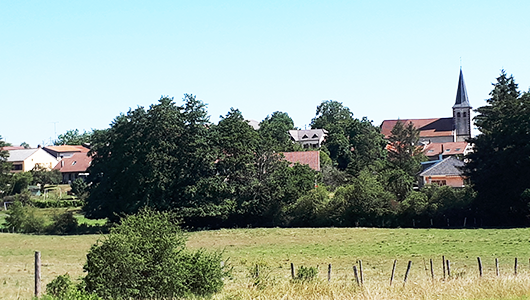Hertzing
Durée visite : 10 minutes
Moyen : Pédestre
Des vestiges d’une villa romaine ont été découverts. Mais Hertzing viendrait du patronyme germanique Hersend. Dépendance médiévale des évêques de Metz, le village fut donné en fief aux Lutzelbourg et aux seigneurs de Réchicourt, aux 16e et 17e siècles. En 2017, la commune compte 190 habitants.
Remains of a Roman villa have been discovered. But Hertzing would come from the Germanic patronymic Hersend. Medieval dependency of the bishops of Metz, the village was given as a fiefdom to the Lutzelbourgs and the lords of Réchicourt, in the 16th and 17th centuries. In 2017, the town had 190 inhabitants.
Überreste einer römischen Villa wurden entdeckt. Aber Hertzing würde vom germanischen Patronym Hersend kommen. Mittelalterliche Abhängigkeit der Bischöfe von Metz, das Dorf wurde im 16. und 17. Jahrhundert als Lehen an die Lutzelburger und die Herren von Réchicourt übergeben. Im Jahr 2017 hatte die Stadt 190 Einwohner.

Parti de gueules au dextrochère de carnation, vêtu d’azur, mouvant d’un nuage d’argent, tenant une épée d’argent garnie d’or, accostée de deux cailloux du même, et d’or au lion d’azur, armé, lampassé et couronné d’or.
Ce sont à dextre les armes du chapitre cathédrale de Metz, et à senestre celles de la famille de Lutzelbourg, qui se partageaient la seigneurie.
Party Gules with dextrochère of carnation, clothed in azure, moving with a cloud of silver, holding a sword argent garnished with gold, accosted with two pebbles of the same, and or with the lion azure, armed, langued and crowned with gold.
These are the arms of the cathedral chapter of Metz on the right, and on the left those of the Lutzelbourg family, who shared the seigneury.
Party Gules mit Nelken-Dextrochère, in Azurblau gekleidet, mit einer Silberwolke bewegten, ein mit Gold garniertes Schwert in der Hand, mit zwei Kieselsteinen desselben angesprochen, oder mit dem Löwen-Azurblau, bewaffnet, geschmückt und mit Gold gekrönt.
Dies sind die Arme des Domkapitels von Metz rechts und links die der Familie Lutzelbourg, die das Seigneury teilte.
Les points de visites
.
L’église date de 1732. Elle abrite un buste reliquaire de Saint-Antoine du 19e siècle. Admirez le très beau chemin de croix. Les vitraux sont en partie dus à Bohl de Haguenau. Ils datent de la première annexion. Ils sont souvent offerts par des paroissiens en remerciement d’une grâce. Saint-Antoine de Padoue est en effet très sollicité. Il est surnommé le thaumaturge, c’est-à-dire le guérisseur. Né à Lisbonne en 1195, il rejoignit le tout jeune Ordre des Franciscains en 1220. Saint François d’Assise l’envoya convertir les cathares en Pays Albigeois. En 1231, il prêche à Padoue où il meurt la même année. Canonisé dés 1232, son culte fut propagé par les navigateurs portugais. Patron des marins, des naufragés et des prisonniers, il est aussi invoqué pour retrouver des objets perdus. En effet, on raconte qu’un voleur, soudain repenti, lui aurait rendu ses commentaires sur les psaumes.
The church dates from 1732. It houses a 19th century reliquary bust of Saint-Antoine. Admire the very beautiful Stations of the Cross. The stained glass windows are partly due to Bohl de Haguenau. They date from the first annexation. They are often offered by parishioners as a thank you for a grace. Saint Anthony of Padua is in fact very much in demand, nicknamed the miracle worker, that is to say the healer. Born in Lisbon in 1195, he joined the very young Order of Franciscans in 1220. Saint Francis of Assisi sent him to convert the Cathars in the Albigensian Country. In 1231, he preached in Padua where he died the same year. Canonized in 1232, his cult was propagated by Portuguese navigators. Patron saint of sailors, castaways and prisoners, he is also invoked to find lost objects. Indeed, it is said that a thief, suddenly repented, would have returned his comments on the psalms.
Die Kirche stammt aus dem Jahr 1732. Sie beherbergt eine Reliquienbüste von Saint-Antoine aus dem 19. Jahrhundert. Bewundern Sie die sehr schönen Stationen des Kreuzes. Die Glasfenster sind teilweise Bohl de Haguenau zu verdanken. Sie stammen aus der ersten Annexion. Sie werden oft von Gemeindemitgliedern als Dankeschön für eine Gnade angeboten. Der heilige Antonius von Padua ist in der Tat sehr gefragt, genannt der Wundertäter, das heißt der Heiler. Er wurde 1195 in Lissabon geboren und trat 1220 dem sehr jungen Franziskanerorden bei. Der Heilige Franziskus von Assisi sandte ihn, um die Katharer im albigensischen Land zu bekehren. 1231 predigte er in Padua, wo er im selben Jahr starb. 1232 kanonisiert, wurde sein Kult von portugiesischen Seefahrern propagiert. Als Schutzpatron der Seeleute, Castaways und Gefangenen berief er sich auch darauf, verlorene Gegenstände zu finden. In der Tat wird gesagt, dass ein Dieb, der plötzlich Buße tat, seine Kommentare zu den Psalmen zurückgegeben hätte.
.






